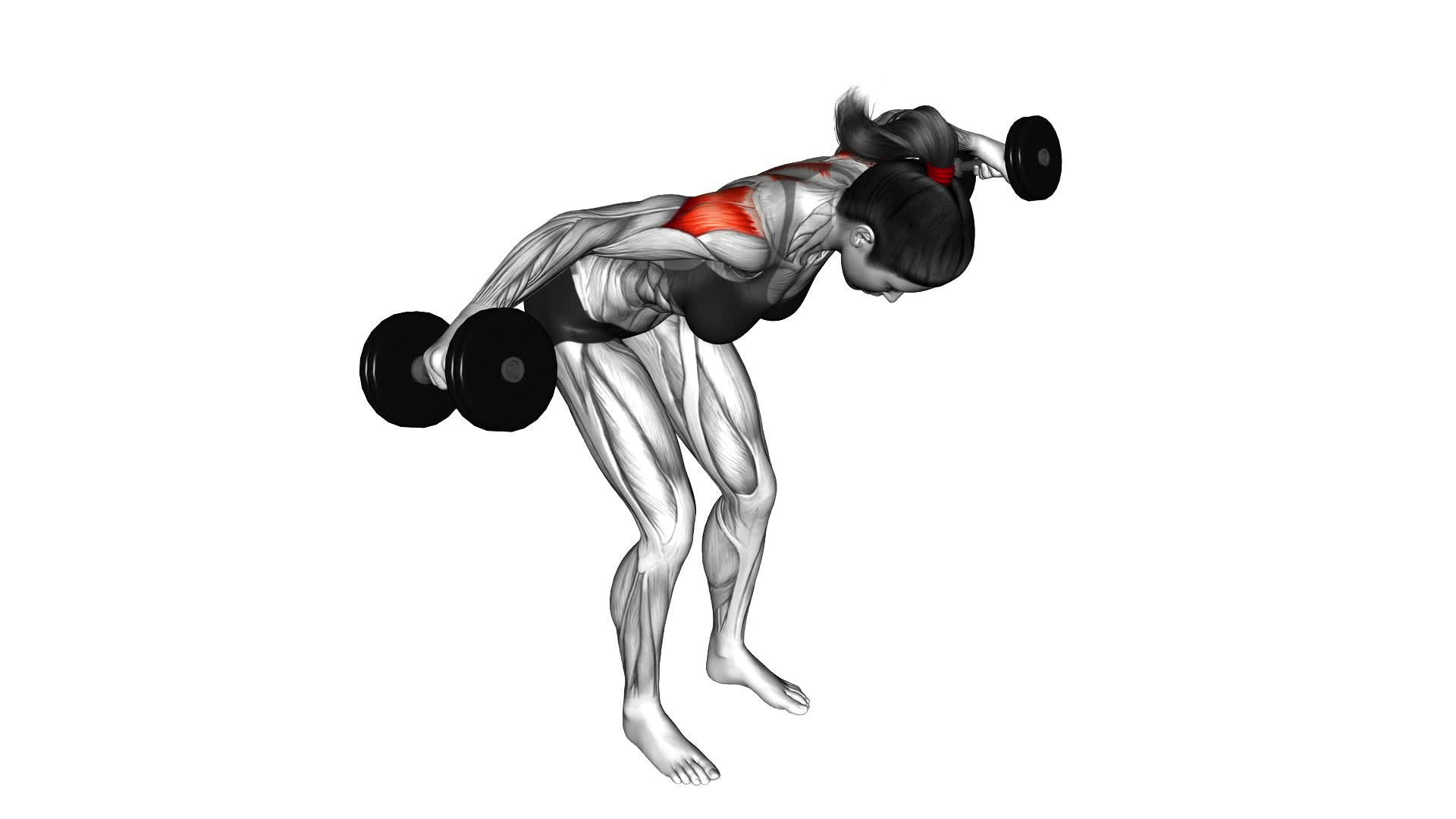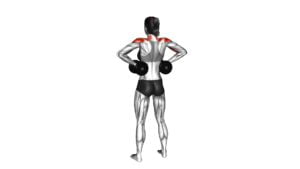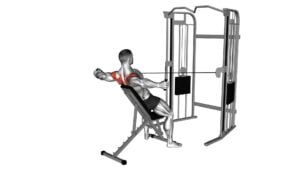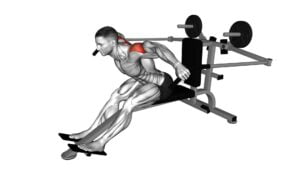Dumbbell Rear Delt Fly (female) – Video Exercise Guide & Tips

Get ready to tone and strengthen your rear delts with the dumbbell rear delt fly!
Watch This Exercise Video
In this video exercise guide, we'll show you the proper form and technique to maximize your results.
Whether you're a beginner or more advanced, we've got variations and progressions to challenge you.
Avoid common mistakes and follow our tips for a killer workout.
Grab those dumbbells and get ready to feel the burn!
Key Takeaways
- The Dumbbell Rear Delt Fly targets the rear deltoid muscles and improves posture.
- It enhances shoulder stability and reduces the risk of shoulder injuries.
- The exercise can be modified for beginners or those with limited shoulder strength.
- To maximize results, maintain proper form, gradually increase resistance, and incorporate variations into your workout routine.
Benefits of the Dumbbell Rear Delt Fly
To maximize the effectiveness of your workout, incorporate the dumbbell rear delt fly for its numerous benefits. This exercise specifically targets your rear deltoid muscles, which are located at the back of your shoulders. By strengthening these muscles, you can improve your posture, enhance shoulder stability, and reduce the risk of shoulder injuries.
To perform the dumbbell rear delt fly, start by standing with your feet shoulder-width apart, holding a dumbbell in each hand. Bend your knees slightly and hinge forward at the hips, keeping your back straight. Raise your arms out to the sides, maintaining a slight bend in your elbows, and squeeze your shoulder blades together as you lift the dumbbells up to shoulder height. Pause for a moment, then slowly lower the weights back down.
To modify this exercise, you can use lighter dumbbells or resistance bands if you're a beginner or have limited shoulder strength. Alternatively, you can perform the exercise while seated on a bench to provide additional support. Remember to maintain proper form throughout the movement, keeping your core engaged and avoiding any swinging or jerking motions.
Proper Form and Technique
Maintain proper form and technique while performing the dumbbell rear delt fly to ensure maximum effectiveness and avoid injury. Proper form is crucial for targeting the rear delts effectively. One of the most common errors is using excessive weight, which can compromise your form and lead to injury. It's important to start with a weight that allows you to maintain control throughout the exercise.
To begin, stand with your feet shoulder-width apart and slightly bend your knees. Hold a dumbbell in each hand with your palms facing inwards, resting the dumbbells against the front of your thighs. Engage your core and maintain a slight bend in your elbows.
As you exhale, raise your arms out to the sides, keeping your elbows slightly bent. Focus on squeezing your shoulder blades together and feeling the contraction in your rear delts. Avoid using momentum or swinging your body to lift the weights.
Throughout the movement, it's important to keep your back straight and maintain a neutral spine. Avoid rounding your shoulders or arching your back.
By following these best practices and maintaining proper form and technique, you can maximize the effectiveness of the dumbbell rear delt fly and minimize the risk of injury.
Now, let's explore some variations and progressions to further challenge your rear deltoids.
Variation and Progressions
Continuing from proper form and technique, you can further challenge your rear deltoids with variations and progressions. It's important to keep your workouts dynamic and constantly push yourself to new limits.
When it comes to the dumbbell rear delt fly exercise, there are several progression options you can explore to continue building strength and stability in your rear delts.
One progression option is to increase the weight of the dumbbells you're using. As you become more comfortable with the exercise and your muscles adapt, adding more weight will help to stimulate further muscle growth. However, be sure to maintain proper form and technique, even with the increased weight.
Another way to progress the exercise is by introducing alternative exercises that target the same muscle group. For example, you can try performing rear delt flys using resistance bands instead of dumbbells. This will provide a different type of resistance and challenge your muscles in a new way.
Additionally, you can incorporate other exercises that target the rear deltoids, such as bent over rows or face pulls, into your routine. This will help to further strengthen and define your rear delts from different angles.
Common Mistakes to Avoid
One common mistake to avoid when performing the dumbbell rear delt fly exercise is improper posture. Maintaining proper posture is crucial to ensure effective targeting of the rear deltoid muscles and to prevent any potential injury. To maintain proper posture, make sure to keep your back straight, shoulders down and relaxed, and chest lifted throughout the entire exercise.
Another common mistake to avoid is using too much weight. It's important to start with lighter weights and gradually increase the weight as you become stronger and more comfortable with the exercise. Using too much weight can compromise your form and increase the risk of injury.
Additionally, avoid swinging your body or using momentum to lift the weights. This diminishes the effectiveness of the exercise and puts unnecessary strain on other muscles. Instead, focus on controlled and smooth movements, keeping your arms and elbows slightly bent throughout the exercise.
Tips for Maximizing Results
To get the most out of your dumbbell rear delt fly exercise, focus on the following tips for improving technique and workout modifications.
Firstly, it's crucial to maintain proper form throughout the exercise. Keep your back straight, core engaged, and shoulders relaxed. This will ensure that you're targeting the rear deltoids effectively and minimizing the risk of injury.
Secondly, start with lighter weights and gradually increase the resistance as you become more comfortable with the movement. This will allow you to focus on proper form and prevent straining your muscles.
Next, pay attention to your range of motion. When performing the rear delt fly, make sure to fully extend your arms backward and squeeze your shoulder blades together at the top of the movement. This will maximize the activation of the rear deltoids.
Additionally, consider incorporating variations into your workout routine. You can try performing the exercise while lying face down on an incline bench or using resistance bands instead of dumbbells. These modifications can help target the rear deltoids from different angles and provide a new challenge for your muscles.
Remember, consistency is key. Aim to perform this exercise at least twice a week to see significant results in your rear deltoid muscles.
Frequently Asked Questions
How Many Sets and Repetitions Should I Do for the Dumbbell Rear Delt Fly Exercise?
For the dumbbell rear delt fly exercise, it's important to consider the weight, proper form, sets, and repetitions.
To determine the number of sets and reps, you should consider your fitness level and goals. Generally, it's recommended to start with 2-3 sets of 12-15 repetitions. However, if you're a beginner, you may want to start with lighter weights and fewer reps.
As you progress, you can gradually increase the weight and reps for more challenge and muscle growth.
Can the Dumbbell Rear Delt Fly Exercise Be Performed Without Dumbbells or Any Other Equipment?
Yes, the dumbbell rear delt fly exercise can be performed without dumbbells or any other equipment. There are alternative exercises without equipment that you can do to target your rear deltoids.
For example, you can try bent-over rear delt raises using just your bodyweight. Another modification for beginners is to perform the exercise with lighter objects like water bottles or cans.
Remember to focus on proper form and gradually increase the intensity as you progress.
Is the Dumbbell Rear Delt Fly Exercise Suitable for Beginners?
To perform the dumbbell rear delt fly exercise with proper form, start by standing with your feet shoulder-width apart and a slight bend in your knees. Hold a dumbbell in each hand with your palms facing inwards.
Keeping your back straight, hinge forward at the hips until your upper body is parallel to the ground. Exhale and lift the dumbbells out to the sides, squeezing your shoulder blades together.
For beginners, start with lighter weights or even no weights at all and focus on mastering the correct technique before progressing.
Are There Any Alternative Exercises That Target the Same Muscles as the Dumbbell Rear Delt Fly?
If you're looking for alternative exercises that target the same muscles as the dumbbell rear delt fly, there are a few options you can try.
One option is the cable rear delt fly, which can help strengthen and tone your rear deltoid muscles.
Another alternative is the bent-over dumbbell lateral raise, which also targets the rear delts.
Lastly, you can try the face pull exercise, which works the rear delts as well as other muscles in the upper back and shoulders.
Can the Dumbbell Rear Delt Fly Exercise Help Improve Posture?
The dumbbell rear delt fly exercise can indeed improve your posture. By targeting the rear deltoid muscles, this exercise helps strengthen your shoulders, which in turn can improve your overall posture.
To perform this exercise effectively, hold a dumbbell in each hand, bend forward at the waist, and lift your arms out to the side, squeezing your shoulder blades together.
This exercise is a great way to enhance shoulder strength and ultimately improve your posture.
Conclusion
In conclusion, the dumbbell rear delt fly is an effective exercise for targeting the rear deltoid muscles in the shoulders.
By maintaining proper form and technique, you can maximize the benefits of this exercise.
Additionally, incorporating variations and progressions can help to challenge your muscles and promote further development.
Avoiding common mistakes and following these tips will ensure that you achieve optimal results from your dumbbell rear delt fly workouts.

Author
Years ago, the spark of my life’s passion ignited in my mind the moment I stepped into the local gym for the first time. The inaugural bead of perspiration, the initial endeavor, the very first surge of endorphins, and a sense of pride that washed over me post-workout marked the beginning of my deep-seated interest in strength sports, fitness, and sports nutrition. This very curiosity blossomed rapidly into a profound fascination, propelling me to earn a Master’s degree in Physical Education from the Academy of Physical Education in Krakow, followed by a Sports Manager diploma from the Jagiellonian University. My journey of growth led me to gain more specialized qualifications, such as being a certified personal trainer with a focus on sports dietetics, a lifeguard, and an instructor for wellness and corrective gymnastics. Theoretical knowledge paired seamlessly with practical experience, reinforcing my belief that the transformation of individuals under my guidance was also a reflection of my personal growth. This belief holds true even today. Each day, I strive to push the boundaries and explore new realms. These realms gently elevate me to greater heights. The unique combination of passion for my field and the continuous quest for growth fuels my drive to break new ground.



